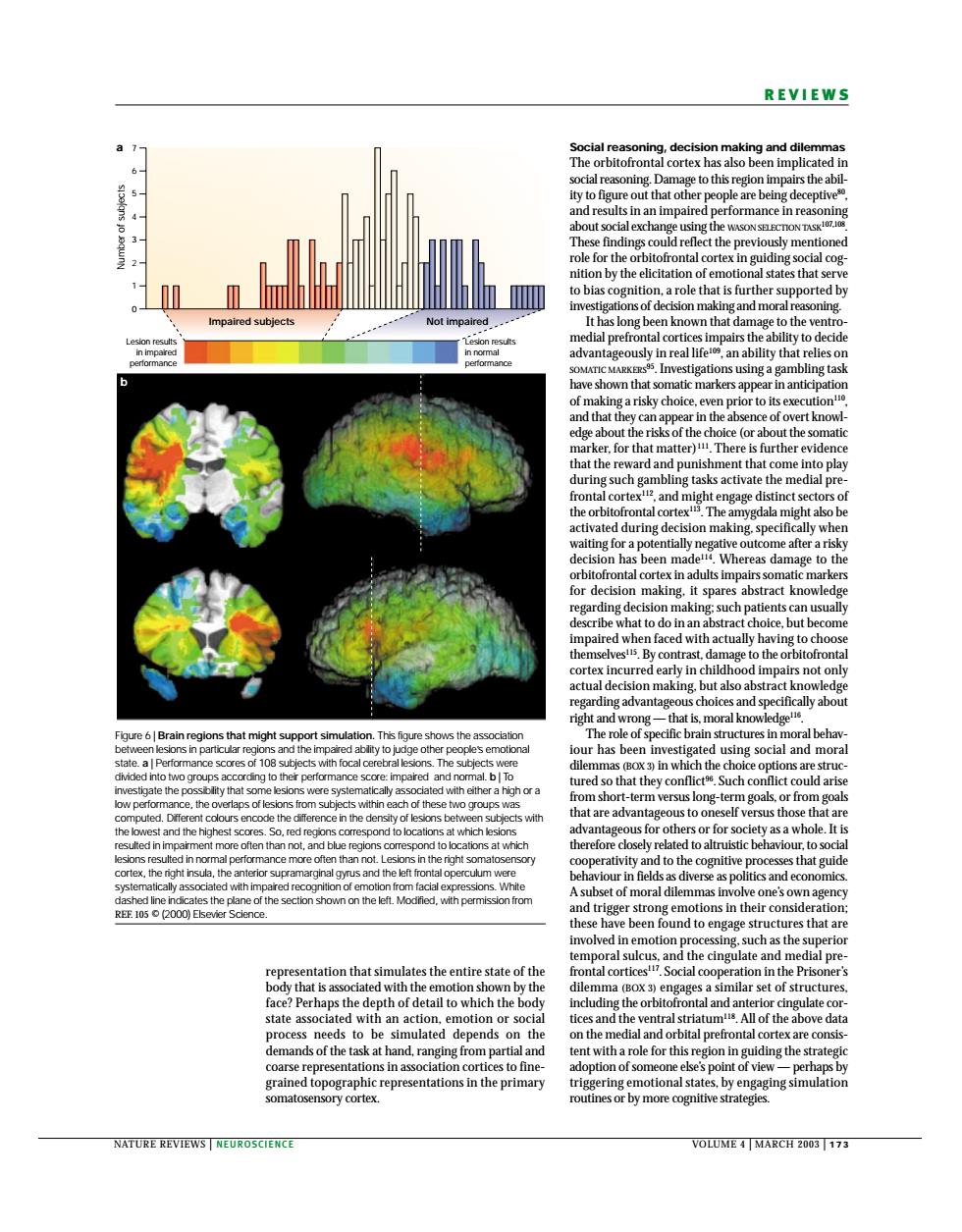正在加载图片...

REVIEWS and di decept process nee ds to simulated depends on t coarse re representations in the primary 好gg OLUME 4 MARCH 200317NATURE REVIEWS | NEUROSCIENCE VOLUME 4 | MARCH 2003 | 173 REVIEWS Social reasoning, decision making and dilemmas The orbitofrontal cortex has also been implicated in social reasoning. Damage to this region impairs the ability to figure out that other people are being deceptive80, and results in an impaired performance in reasoning about social exchange using the WASON SELECTION TASK107,108. These findings could reflect the previously mentioned role for the orbitofrontal cortex in guiding social cognition by the elicitation of emotional states that serve to bias cognition, a role that is further supported by investigations of decision making and moral reasoning. It has long been known that damage to the ventromedial prefrontal cortices impairs the ability to decide advantageously in real life109, an ability that relies on SOMATIC MARKERS95. Investigations using a gambling task have shown that somatic markers appear in anticipation of making a risky choice, even prior to its execution110, and that they can appear in the absence of overt knowledge about the risks of the choice (or about the somatic marker, for that matter)111. There is further evidence that the reward and punishment that come into play during such gambling tasks activate the medial prefrontal cortex112, and might engage distinct sectors of the orbitofrontal cortex113. The amygdala might also be activated during decision making, specifically when waiting for a potentially negative outcome after a risky decision has been made114. Whereas damage to the orbitofrontal cortex in adults impairs somatic markers for decision making, it spares abstract knowledge regarding decision making; such patients can usually describe what to do in an abstract choice, but become impaired when faced with actually having to choose themselves115. By contrast, damage to the orbitofrontal cortex incurred early in childhood impairs not only actual decision making, but also abstract knowledge regarding advantageous choices and specifically about right and wrong — that is, moral knowledge116. The role of specific brain structures in moral behaviour has been investigated using social and moral dilemmas (BOX 3) in which the choice options are structured so that they conflict96. Such conflict could arise from short-term versus long-term goals, or from goals that are advantageous to oneself versus those that are advantageous for others or for society as a whole. It is therefore closely related to altruistic behaviour, to social cooperativity and to the cognitive processes that guide behaviour in fields as diverse as politics and economics. A subset of moral dilemmas involve one’s own agency and trigger strong emotions in their consideration; these have been found to engage structures that are involved in emotion processing, such as the superior temporal sulcus, and the cingulate and medial prefrontal cortices117. Social cooperation in the Prisoner’s dilemma (BOX 3) engages a similar set of structures, including the orbitofrontal and anterior cingulate cortices and the ventral striatum118. All of the above data on the medial and orbital prefrontal cortex are consistent with a role for this region in guiding the strategic adoption of someone else’s point of view — perhaps by triggering emotional states, by engaging simulation routines or by more cognitive strategies. representation that simulates the entire state of the body that is associated with the emotion shown by the face? Perhaps the depth of detail to which the body state associated with an action, emotion or social process needs to be simulated depends on the demands of the task at hand, ranging from partial and coarse representations in association cortices to finegrained topographic representations in the primary somatosensory cortex. 7 6 5 4 3 2 1 0 Impaired subjects Not impaired Number of subjects a b Lesion results in normal performance Lesion results in impaired performance Figure 6 | Brain regions that might support simulation. This figure shows the association between lesions in particular regions and the impaired ability to judge other people’s emotional state. a | Performance scores of 108 subjects with focal cerebral lesions. The subjects were divided into two groups according to their performance score: impaired and normal. b | To investigate the possibility that some lesions were systematically associated with either a high or a low performance, the overlaps of lesions from subjects within each of these two groups was computed. Different colours encode the difference in the density of lesions between subjects with the lowest and the highest scores. So, red regions correspond to locations at which lesions resulted in impairment more often than not, and blue regions correspond to locations at which lesions resulted in normal performance more often than not. Lesions in the right somatosensory cortex, the right insula, the anterior supramarginal gyrus and the left frontal operculum were systematically associated with impaired recognition of emotion from facial expressions. White dashed line indicates the plane of the section shown on the left. Modified, with permission from REF. 105 © (2000) Elsevier Science